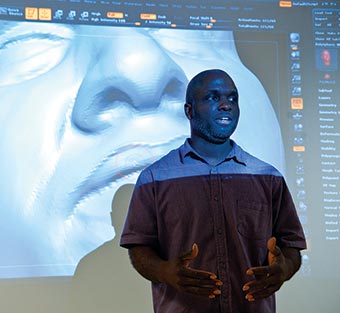Spotlight
Highly Animated
| USF News

Assistant professor McArthur Freeman II, who teaches a course in 3-D animation, says just about anyone with a story to tell, a model to create or an idea to illustrate can benefit from 3-D animation.
Photo by Aimee Blodgett | USF News
A new animation studio in USF's College of The Arts is more than a creative adventure — it's a training ground for students on the latest generation of equipment and software.
And it isn't just for art students.
Today more than ever, cartoonists, architects, designers, fine artists and even engineers are using animation to great effect. Just about anyone with a story to tell, a model to create or an idea to illustrate can benefit from 3-D animation.
Mastery of the tools is a fundamental goal in the school's animation courses. A new professor teaching students the requisite skills expects even more.
"I'm also really interested in how this technology will enhance how students work with disciplines other than their own," says assistant professor McArthur Freeman II. "These tools can extend what we can offer each discipline as well."
Animation technology is well-suited to manipulating scans and captures taken for surveying, mobile mapping, and architectural modeling, making the training useful to geographers, historians, forensic scientists, archaeologists, people who work in museums and even real estate agents.
The new lab is drawing students from the School of Mass Communications, the College of Engineering and even the departments of Geology and Anthropology, as well as every school in the College of The Arts.
USF's Digital Video and Electronic Arts Program in the School of Art and Art History has already caught the eye of Animation Career Review, which recommended the program as one of the top programs in the country for studying the digital arts. The publication calls it a "course load that incorporates a multidisciplinary education into one rock star program." The Review lauded the 24-hour availability of the program's "enviable" labs, including an Adobe software studio, a 16-seat Apple studio and a "media cage" where students "can explore possibilities and develop their individual artistic voices."